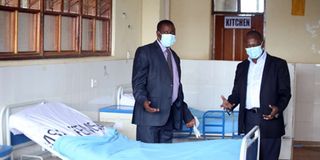Samburu County grapples with Covid-19

A Covid-19 Isolation ward at the Maralal County Referral Hospital in Samburu.
What you need to know:
- The Samburu case was a truck driver who had ferried goods to the county and infected a loader.
- County government officials believe clear messaging bought them time.
- It is a month since the county reported its first case and the number has risen to 46.
For 144 days, Samburu County was a bystander as the rest of Kenya battled Covid-19.
The first case in the country was confirmed on March 12, but it wasn’t until August 4 that the first case was reported in Samburu — the last county to report an infection.
The Samburu case was a truck driver who had ferried goods to the county and infected a loader, who then infected friends, and that is how community infection started in the county.
County government officials believe clear messaging bought them time.
It is a month since the county reported its first case and the number has risen to 46.
Being a county with a weak healthcare system that has in the past been severely affected by drought and alarming rates of food insecurity that put a strain on livelihoods, the county administrators did not want to take chances.
Inspecting travellers
The Samburu County government took action as soon as its neighbours reported cases. The county, which is 380 kilometres from Nairobi, began inspecting travellers coming from the city.
It collected samples from them and tested at the Moi Teaching and Referral Hospital, just to be sure there was no community transmission. County Health executive Stephen Lekupe attributed Samburu’s early and effective response to past experiences.
“Given that we have suffered and lost many people just to a simple drought and lack of water, the county knows it must be on its fullest guard whenever any major problem emerges to protect its people,” said Mr Lekupe.
However, he is worried by the slow release of the testing kits to the county by the national government.
“We were on the right track while we were testing at MTRH. It would be faster and the facility would reimburse and match the number of testing kits with that of the samples,” Mr Lekupe told Nation in his office last week.
However, for two weeks now, the county has been waiting for Covid-19 results of 300 samples taken to the Kenya Medical Research Institute for testing, with Mr Lekupe expressing fear that infections are likely going on.
The county has less than five testing kits, preserved for the worst cases and it has to wait for the national government to provide new ones. The national testing labs having a backlog of samples to be tested.
Other problems
There are other problems. Home-based care is near-impossible with manyattas being the predominant house designs in the area.
“One manyatta is shared by seven or eight people: no bedroom, no kitchen; making it worse for us to even practise the home-based care programme,” said Mr Sam Nakope, the Samburu chief officer for Health.
Prevention measures such as handwashing are complicated by lack of water in most places.
In fighting the new enemy, the biggest worry for community health worker Andrew Lekuta is the fact that the hygiene standards in the community are low. There are few toilets and handwashing is barely a reality.
Despite the county getting Sh27.4 million from the national government to put together 300 isolation beds, none of the quarantine centres is ready to host patients. Out of the planned 305 beds, only about 20 have been properly installed.





